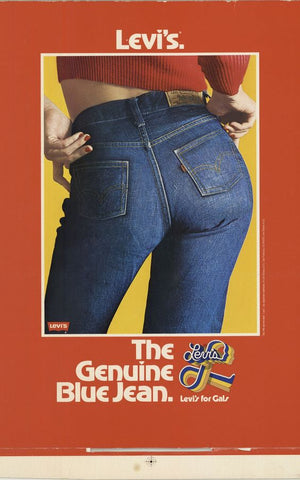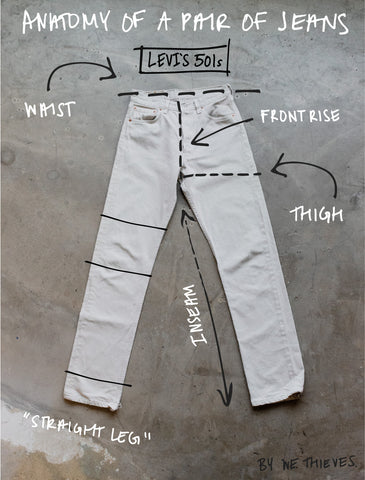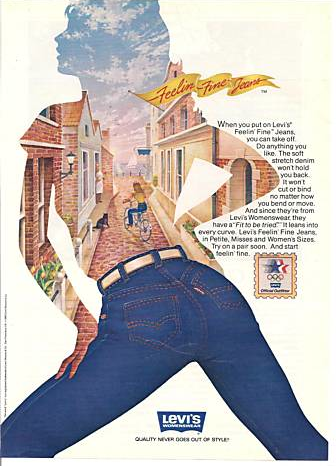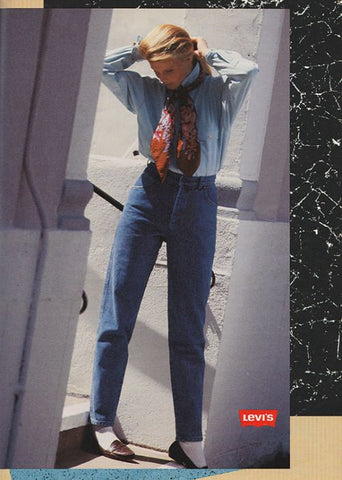Vintage Levi's: A Basic Fit Guide

Shopping for vintage Levi's is a bit like dating. It requires patience, trial and error and often asks us to try a few pairs on before we find "the one".
A couple of things to keep in mind when shopping for vintage Levi's.
- Vintage denim is unlike modern denim where it rarely has stretch woven in with the cotton. This means it's not going to morph around our bodies the way modern with stretch does.
- You will have to size up two to sometimes four sizes depending on the jean.
- Pricing varies on vintage denim based on its age, where it was made (USA more expensive), and how hard it is to source.
- You the buyer have to pretty committed to trying on more than one pair before finding the one!
There are exhaustive resources online for getting schooled on the nitty-gritty details of vintage Levi's (in terms of age and other details), but this is not one of those sources. We are focusing on FIT here.
Let's start with some basic terminology before we go into describing the different styles to ensure we know the elements of fit - in particular the key points of measure. These key points are critical for those of you TRYING to find vintage denim online. I don't know about you, but I will never buy vintage denim online. This is one item that truly needs to be tried on, especially for first time buyers.

- Waist: The measurement across the top edge of the jean, when the front and back sides are lined up, then doubled.
- Rise: This is the measurement of the base of the crotch to the top of the waist. There is a front rise and a back rise and each denim cut will have different measurements of each depending on the style and how it was designed to fit.
- Inseam: The measurement of the crotch to the hem. We don't focus on inseam very much in our store because we can't feasibly stock each waist size and inseam size - therefore we offer alteration alternatives for folks who want their denim altered.
- Straight leg: With denim laid flat - the measurement of knee, calf, and hem are equal. No change.
- Boot cut: The measurement from below the knee down is slightly wider than the knee to make room for the shaft of a boot.
- Flare (bellbottom) The measurement of the knee is narrower than the thigh and the hem is wider than the thigh and knee combined (a flare width can vary depending on the style).
Understanding Vintage Denim Sizing
Throw out all you've been conditioned by modern brands of your "size". It's important to know your key points of measure (waist, thigh, inseam) by measuring it.
Tip: Keep your measurements handy (on your phone).
Then, understand your body shape. Are you a pear, triangle, inverted triangle, hour glass, or rectangle? Perhaps a separate blog post is needed on that but you can google it. Do you have a long torso or a shorter one? Some mid-rise jeans are high rise on folks with a shorter torso etc. and each style of jean fits our shapes differently.
We get a lot of women who say, "I want 501's" and then realize that 501 just isn't their jean. It's why we stock different types, because we know we are all shaped differently.
Expect to size up 2-4 sizes when shopping vintage. Always ask for the measured waist size (as opposed to marked size) when you shop online.
- OUR RULE: Don't get sucked into the waist size marked so much, find the pair that fits you best.
- Vintage denim will stretch as you wear it from a half-inch to whole inch from the heat of your body (time and temperature). This all opens the fibers tightened by washing and the jeans become your best friends. We have found that the measured waist is always usually smaller than the marked waist, and the marked waist is what the denim stretch to.
- No two of the same sizes of the same cut will fit the same. EACH AND EVERY PAIR will fit differently for several reasons including the year they were produced, the facility they were produced in, and the shape of their previous owner. YES - vintage denim will take on the nuances of their owner.
- Ideally, you want the jeans to fit a little bit tight at first - KNOW they will open up everywhere including waist, hips, thighs.

Vintage Levi's Fit Guide
Levi's 501's (the OG style)- Introduced in 1873, known then as the XX
- This is a button fly / straight leg / mid-rise fit
- Pricing varies tremendously on this based on age and condition. Many can often go north of $1000 for those collecting these classics.
- Booty magic as the back panel of fabric on a 501 is cut wider than the front panel. That means that the fabric from the back panel wraps around your rear to give it a hug & lift.

- Introduced in 1967
- Zip fly / straight leg / mid-rise
- The hip on the 505 tends to run narrow and it's cut very straight
- 505's from the 70s will have a higher rise than the 90s
- Back and front panels are equal width, unlike the 501
- A crisp and tailored look

- Introduced in 1969
- Zip fly / mid to high-rise / boot-cut or subtle flare
- The flare can create the illusion of longer legs so can be very flattering depending on your shape.
- 517s from the 70s, which often have an orange tab on the back pocket, have more of a high waist look, while 90s 517s are more of a mid-rise.
- The 70s are Harder to find and often command higher $
- Introduced in 1985
- Zip fly / high rise / tapered leg
- Fuller through the thigh, tapered down to the knee, and continues to taper to hem - meaning the measurement of the knee is narrower than the thigh, and measurement of hem opening is narrower than the knee.
- The highest of the rises, this tends to serve as the classic Mom Jean, even though it was designed for men, too. This style also comes in slightly at the waist and is ideal for women with a "Bonita Applebaum" shape - small waist, fuller hips and thighs.
- The back rise is nice and high so very very nice for women with curves.

- Released in the 90s
- Zip fly / slim / tapered leg
- This is the “tightest” of the vintage jeans in terms of fit.
- Tapers down thigh through knee down to hem
- In “vintage” terms this is not necessarily the most “referenced” jean, BUT it has turned into highly covetable by many fashionistas seeking a slim fit vintage pair.

Finding vintage denim requires a bit of patience and the commitment to try on several pair - but once you find them, we promise that they turn into the one item you often can't live without!
We literally cannot list all our vintage denim on our website. We sell them too quickly in our store. We highly recommend that you reach out to us to see if we have your size and you can come on in for a try on session OR you can make a virtual appointment for us to size you up and assess which style, based on the above information, might work best for you (whether you buy in our store or elsewhere). We find a more empowered consumer makes better choices and that's important to us.
2 comments
What you have information regarding 521 Levi’s? How do they compare with the 550?
Need info please!!! I have a 1970’s pair of Levi’s—size 58×34 that are mint with all tags. Would like to sell but cannot find any comparisons on my computor. Can you please help me with a price value of some kind? Thank you so very much!!
